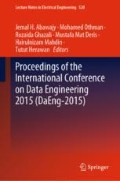Abstract
Extracting relevant resources according to a query is imperative due to the factors of time and accuracy. This study proposes a model that enables query matching using output lattices from Formal Concept Analysis (FCA) tool, based on Graph Theory. The deployment of FCA concept lattices ensures that the matching is done based on extracted concepts; not just mere keywords matching hence producing more relevant results. The focus of this study is on the method of Concept Based Lattice Mining (CBLM) where similarities among output lattices will be compared using their normalized adjacency matrices, utilizing a distance measure technique. The corresponding trace values obtained determines the degree of similarities among the lattices. An algorithm for CBLM is proposed and preliminary experimentation demonstrated promising results where lattices that are more similar have smaller trace values while higher trace values indicates greater dissimilarities among the lattices.
Access this chapter
Tax calculation will be finalised at checkout
Purchases are for personal use only
Notes
- 1.
A directed graph where the constellation of the relevant attribute values responsible for the position of the object is exhibited.
References
Salton, G., McGill, M.J.: Introduction to Modern Information Retrieval. Mc Graw Hills Book Co., New York (1983)
Wang, Y., et al.: Concept-Based Web Search in Conceptual Modeling, pp. 449–462. Springer, Berlin (2012)
Chandrasekaran, B., Josephson, J.R., Benjamins, V.R.: What are ontologies, and why do we need them? IEEE Intell. Syst. 14(1), 20–26 (1999)
Hepp, M.: Possible ontologies: how reality constrains the development of relevant ontologies. Int. Comput. 11(1), 90–96 (2007)
Stavrianou, A., Andritsos, P., Nicoloyannis, N.: Overview and semantic issues of text mining. SIGMOD Record 36(3), 23–34 (2007)
Van Rijsbergen, C.J.: Information Retrieval, 2nd edn. Butterworths, London (1979)
Hearst, M.: What is Text Mining. 2003 [cited 2013 May 20, 2013]; Available from http://people.ischool.berkeley.edu/~hearst/text-mining.html
Gupta, V., Lehal, G.S.: A survey of text mining techniques and applications. J. Emerg. Technol. Web Intell. 1(1), 60–76 (2009)
Ganter, B., Wille, R.: Formal Concept Analysis. Mathematical Foundations. Springer, Berlin (1999)
Eklund, P., Villerd, J.: A survey of hybrid representations of concept lattices in conceptual knowledge processing. In: Kwuida, L., Sertkaya, B. (eds.) Formal Concept Analysis: ICFCA 2010, pp. 296–311. Springer, Berlin (2010)
Wolff, K.E.: A first course in formal concept analysis—how to understand line diagrams. Adv. Stat. Softw. 4, 429–438 (1993)
West, D.B.: Introduction to Graph Theory, vol. 2. Prentice Hall, Englewood Cliffs (2001)
Shirinivas, S., Vetrivel, S., Elango, N.: Applications of graph theory in computer science: an overview. Int. J. Eng. Sci. Technol. 2(9), 4610–4621 (2010)
Riaz, F., Ali, K.M.: Applications of graph theory in computer science. In: 2011 Third International Conference on Computational Intelligence, Communication Systems and Networks (CICSyN). IEEE, New York (2011)
Rosen, K.H., Krithivasan, K.: Discrete Mathematics and Its Applications. McGraw-Hill, New York (1999)
Bae, J., et al.: Development of distance measures for process mining, discovery and integration. Int. J. Web Serv. Res. (IJWSR) 4(4), 1–17 (2007)
Bergmann, R., Gil, Y.: Similarity assessment and efficient retrieval of semantic workflows. Inf. Syst. 40, 115–127 (2014)
(JAKIM), J.A.d.k.I.M. IslamGRID: Kemusykilan Agama. 2014 [cited 2014 May 20]. Available from http://kemusykilan.islamgrid.gov.my/
Riesen, K., Emmenegger, S., Bunke, H.: A novel software toolkit for graph edit distance computation. In: Graph-Based Representations in Pattern Recognition, pp. 142–151. Springer, Berlin (2013)
Acknowledgements
This research is partially funded by the Centre of Research and Innovation Management, Universiti Sultan Zainal Abidin, Malaysia.
Author information
Authors and Affiliations
Corresponding author
Editor information
Editors and Affiliations
Rights and permissions
Copyright information
© 2019 Springer Nature Singapore Pte Ltd.
About this paper
Cite this paper
Hassan, H., Mohd Saman, M.Y., Abdullah, Z., Mohamad, M. (2019). Concept Based Lattice Mining (CBLM) Using Formal Concept Analysis (FCA) for Text Mining. In: Abawajy, J., Othman, M., Ghazali, R., Deris, M., Mahdin, H., Herawan, T. (eds) Proceedings of the International Conference on Data Engineering 2015 (DaEng-2015) . Lecture Notes in Electrical Engineering, vol 520. Springer, Singapore. https://doi.org/10.1007/978-981-13-1799-6_9
Download citation
DOI: https://doi.org/10.1007/978-981-13-1799-6_9
Published:
Publisher Name: Springer, Singapore
Print ISBN: 978-981-13-1797-2
Online ISBN: 978-981-13-1799-6
eBook Packages: Intelligent Technologies and RoboticsIntelligent Technologies and Robotics (R0)

